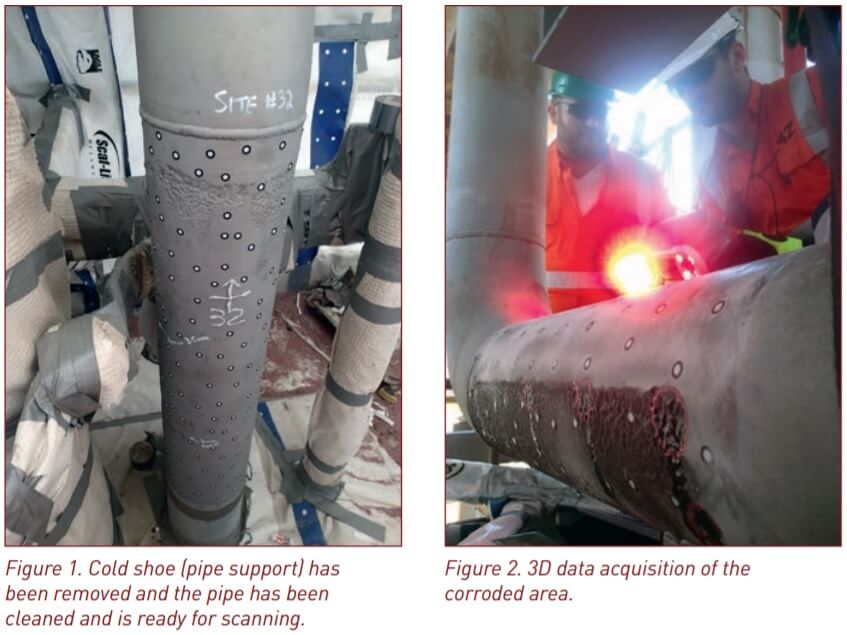Nondestructive testing (NDT) is a broad group of analytical methods used in industries to determine the properties of metals, systems or components without causing damage. This form of testing does not change the item under inspection, which makes NDT one of the most valuable techniques for saving time and money.
3D Laser Scanners – Accurate and Fast
Laser scanners are becoming a tool of choice for nondestructive testing and evaluation. Inspectors armed with portable handheld laser scanners can be deployed to create detailed 3D surface images of corrosion underneath pipe supports or similar structures. The process has proved to be extremely effective, highly accurate and faster than traditional NDT methods. (For another application of nondestructive testing, read Nondestructive CUI Detection Techniques for Process Pipelines.) Forward thinking and entrepreneurial oil and gas companies are starting to reap the benefits by embracing this emerging service. No other inspection methodologies in the market today are capable of delivering such rich and detailed results in such a short period of time.
In a typical evaluation, once the scanning of a pipeline or other structure is complete, the 3D data is brought in from the field, whereupon it is analyzed and delivered in a detailed report. Within minutes, asset integrity engineers can then direct further maintenance and or coating crews to follow through with required remedial work. The net result for the pipeline owner is potential savings through reduced down time and minimized production losses.
A high definition scanner can produces 3D data via laser profilometry (accurate to 0.05 mm), that is perfectly scaled to be representative of the real geometry of the asset being inspected. The realism of the 3D image generated makes for easy visualization of any surface defects, such as corrosion features.

Further post processing of the 3D data produces colorful corrosion maps, detailing wall loss data, corrosion feature dimensions, volumetric loss data, cross sectional profiling and files that can be converted and queried in the future.
Surface Preparation Prior to Laser Scanning
Like any visual inspection method, proper surface preparation is essential. Careful cleaning and removal of any coatings, rust and other visual obstructions from the surface of the asset to be inspected is required prior to laser scanning. (Learn about other best practices in the article Tips for Success in Conducting External Corrosion Direct Assessments.)
How Laser Scanning Works
Hand-held laser scanners create a 3D image through triangulation. A laser line is projected onto the object from the scanner and a sensor measures the distance to the surface. Data is collected in relation to an internal coordinate system. To collect data where the scanner is in motion, the position of the scanner must be determined in relation to the surface. The position is determined by the scanner using reference features on the surface being scanned (retro-reflective targets).
Through continual triangulation and the distance measurement process, a polygonal representation of the surface is formed (a polygonal mesh). Thousands of these small faceted flat surfaces are combined to give the detailed 3D model of the corrosion feature.

Laser scanning is a high-resolution visual inspection process, and will therefore acquire data on everything within the scanner's field of view. Laser scanning should not be confused with radiography or ultrasonic inspections, which are complimentary methods of inspection.
Benefits of Laser Scanning
The resulting data generated by 3D laser scanning is invaluable to integrity engineers and plant operators alike, due to its flexibility and repeatability. It is an archive that can be stored and reused for future comparisons, and it can be changed into a myriad of formats to be imported or used for numerical modelling, and fitness for service assessments and calculations. It can therefore also be shared with consultants, colleagues and other integrity specialists anywhere and looked at and reviewed in ‘real-time’ collaboratively.
3D laser technology is a significant development in the evolution of inspection techniques for corroded assets, and data acquisition on material performance. As costs for maintenance continue to increase, and plant operators continue to push their plants and plant materials further, the need for highly accurate data acquisition and inspection results, which only laser scanning produces, will increase.